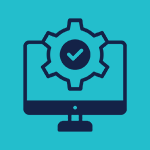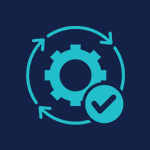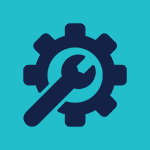
Migrating Legacy Systems: Challenges and Best Practices
Legacy systems are often the backbone of many organizations, handling critical functions such as customer relationship management, supply chain operations, and financial transactions. However, these systems must be updated as technology advances, posing scalability, integration, and security challenges. Migrating legacy systems isn’t just about keeping up with modern technology; it’s about enhancing business agility, reducing operational costs, and improving the overall customer experience. In this blog, we’ll explore the challenges and complexities involved in migrating legacy systems, followed by a comprehensive guide on best practices for a successful migration.
Why Migrate Legacy Systems?
 Understanding the reasons behind migrating legacy systems helps lay the groundwork for addressing the challenges that arise. Legacy systems are not inherently wrong; they have often proven their reliability and stability over the years. However, their limitations become apparent in a rapidly evolving technological environment.
Understanding the reasons behind migrating legacy systems helps lay the groundwork for addressing the challenges that arise. Legacy systems are not inherently wrong; they have often proven their reliability and stability over the years. However, their limitations become apparent in a rapidly evolving technological environment.
Key reasons for migration include:
 Increased Operational Costs: Older systems often require specialized knowledge for maintenance, frequent patching, and legacy hardware, all of which add up to substantial costs over time. For instance, mainframes or outdated database systems may require proprietary skills and expensive support contracts, becoming a financial burden.
Increased Operational Costs: Older systems often require specialized knowledge for maintenance, frequent patching, and legacy hardware, all of which add up to substantial costs over time. For instance, mainframes or outdated database systems may require proprietary skills and expensive support contracts, becoming a financial burden.
Lack of Scalability: Many legacy systems weren’t designed for today’s interconnected and scalable environments, such as cloud-based infrastructures or APIs, which allow for seamless integration and flexibility. Enterprises struggle to expand their operations or scan applications without the ability to scale efficiently.
Security Risks: Legacy systems, particularly those without regular updates, are prone to cyber threats. The lack of vendor support or the inability to patch vulnerabilities exposes organizations to breaches. Additionally, outdated security protocols, such as weak encryption algorithms, make these systems attractive targets for attackers.
Integration Limitations: Integrating legacy systems with modern applications is often cumbersome and may involve workarounds, such as middleware solutions, that could be more sustainable in the long term. It creates data silos, leading to inefficiencies and a lack of real-time visibility into business operations.
Regulatory Compliance: Regulatory bodies frequently update compliance requirements. Legacy systems may not support new standards like GDPR, HIPAA, or PCI DSS, leading to potential penalties or legal issues if sensitive data is mishandled.
Challenges of Migrating Legacy Systems
Migrating a legacy system is a multi-layered process involving significant challenges. Companies must navigate these complexities carefully to ensure a smooth transition.
1. Data Migration and Integrity
Data migration is at the core of any legacy system upgrade. However, transferring data from old systems to new platforms often reveals inconsistencies and complexities.
 Data Compatibility Issues: Legacy systems may use proprietary or obsolete data formats incompatible with modern databases and platforms (e.g., moving from flat files or COBOL-based databases to relational databases like MySQL or cloud-native solutions. Transforming these formats into modern, structured data while preserving relationships and dependencies is a complex task that requires advanced ETL (Extract, Transform, Load) processes.
Data Compatibility Issues: Legacy systems may use proprietary or obsolete data formats incompatible with modern databases and platforms (e.g., moving from flat files or COBOL-based databases to relational databases like MySQL or cloud-native solutions. Transforming these formats into modern, structured data while preserving relationships and dependencies is a complex task that requires advanced ETL (Extract, Transform, Load) processes.
Data Loss and Corruption Risks: Migrating large datasets across platforms can lead to potential data loss or corruption if not handled properly. Even with robust ETL tools, data validation and integrity checks must be rigorously performed to ensure the completeness and accuracy of the migrated data. A common practice is to use checksum algorithms and transaction logs to verify data consistency.
Data Integrity Maintenance: Maintaining data integrity is crucial during migration. For example, ensuring that customer records retain their unique identifiers and relational connections to other data entities like transactions and histories is vital to avoid disruption to business continuity.
2. Downtime and Operational Disruption
System downtime can be a significant issue during migration, affecting both internal operations and customer-facing services.
 Impact on Business Operations: Migration can cause interruptions, resulting in delayed services, inaccessible data, or system outages. For organizations with 24/7 operations (e.g., financial institutions), such downtime can lead to substantial financial losses and damage to their reputation. Hence, careful planning should minimize downtime, such as migrating during off-peak hours or implementing zero-downtime deployment strategies.
Impact on Business Operations: Migration can cause interruptions, resulting in delayed services, inaccessible data, or system outages. For organizations with 24/7 operations (e.g., financial institutions), such downtime can lead to substantial financial losses and damage to their reputation. Hence, careful planning should minimize downtime, such as migrating during off-peak hours or implementing zero-downtime deployment strategies.
User Disruption and Adaptation: Employees accustomed to legacy systems may face difficulties adapting to new technologies, which can impact productivity. Resistance to change is common, especially when employees have used a particular system for years. Providing transitional support and ensuring that critical functions remain accessible during the switch can mitigate these issues.
Integration Delays: Connecting the new system with existing platforms and applications can be delayed if unforeseen compatibility issues arise. API testing and creating middleware solutions can help, but these may introduce additional complexities and require meticulous planning.
3. Security and Compliance Risks
Security concerns are paramount during migration, especially when transferring sensitive data.
 Risk of Data Breaches: Data transfers must be encrypted using robust protocols like TLS (Transport Layer Security) to prevent interception and unauthorized access. In addition, ensuring that the new system complies with security best practices (such as secure coding standards and intrusion detection systems) is essential to protect against vulnerabilities.
Risk of Data Breaches: Data transfers must be encrypted using robust protocols like TLS (Transport Layer Security) to prevent interception and unauthorized access. In addition, ensuring that the new system complies with security best practices (such as secure coding standards and intrusion detection systems) is essential to protect against vulnerabilities.
Regulatory Compliance Requirements: Many industries have strict compliance mandates that dictate how data should be stored, processed, and transferred. For example, healthcare organizations must comply with HIPAA when handling patient data, while financial services firms must adhere to GDPR standards for customer data protection. Any deviation during migration can result in legal penalties.
Legacy System Vulnerabilities: Outdated systems may harbour unpatched security vulnerabilities that can be exploited during migration. Running vulnerability scans and patching known issues before beginning migration minimizes the risk of attacks.
4. Cost and Resource Allocation
Legacy system migration is an expensive and resource-intensive undertaking.
 High Initial Investment: The migration process often requires substantial investment in new hardware, software licenses, and consulting services. The cost of data transformation tools, security solutions, and migration software should also be considered.
High Initial Investment: The migration process often requires substantial investment in new hardware, software licenses, and consulting services. The cost of data transformation tools, security solutions, and migration software should also be considered.
Complex Resource Management: Migration requires assembling specialized teams, including project managers, software engineers, data analysts, and IT security experts. Balancing these resources while maintaining day-to-day operations can stretch the organization’s capacity and budget.
Unexpected Costs: Hidden expenses, such as extending project timelines due to unforeseen complications or scaling infrastructure needs, can significantly inflate the budget.
5. Resistance to Change
Organizations often need help moving away from legacy systems, which can slow down the migration process.
 Employee Pushback: Employees deeply familiar with a legacy system may resist change due to uncertainty or fear of reduced productivity. Resistance can be mitigated through communication and emphasizing the benefits of the new system, such as improved efficiency and reduced manual work.
Employee Pushback: Employees deeply familiar with a legacy system may resist change due to uncertainty or fear of reduced productivity. Resistance can be mitigated through communication and emphasizing the benefits of the new system, such as improved efficiency and reduced manual work.
Training and Adaptation Costs: New systems require training programs tailored to different user levels. Comprehensive training sessions and hands-on workshops can help ease the transition but also add time and cost to the migration process.
Cultural Shifts: Some organizations may have a culture of relying on traditional methods, making introducing a more agile, technology-driven approach challenging. Change in management strategies, including leadership support and ongoing coaching, can foster a culture open to modernization.
DataVision has been crafting software solutions for the Banking and Financial services industry for more than 25 years.
Best Practices for Migrating Legacy Systems
Organizations can follow best practices tailored to the migration process to overcome these challenges.
1. Conduct a Comprehensive System Assessment
 A thorough assessment sets the foundation for a successful migration. Understanding the intricacies of the legacy system, including dependencies, performance metrics, and existing vulnerabilities, is crucial.
A thorough assessment sets the foundation for a successful migration. Understanding the intricacies of the legacy system, including dependencies, performance metrics, and existing vulnerabilities, is crucial.
Legacy System Audit: Perform a detailed audit to document the system architecture, data dependencies, and operational workflows. Identify potential bottlenecks and limitations that may arise during migration.
Feasibility Analysis: Conduct a cost-benefit analysis to determine if migration is the best option or if alternatives like partial modernization or continued support are viable.
Technical and Business Alignment: Align the migration plan with business objectives, ensuring the new system supports the company’s growth, regulatory, and operational requirements.
2. Choose the Appropriate Migration Strategy
Selecting the right migration strategy depends on the system’s complexity and business requirements. The main strategies include:
 Rehosting (Lift and Shift): This method involves moving applications to a new infrastructure with minimal changes. It’s ideal for systems that don’t require optimization but can benefit from modern infrastructure features like cloud hosting.
Rehosting (Lift and Shift): This method involves moving applications to a new infrastructure with minimal changes. It’s ideal for systems that don’t require optimization but can benefit from modern infrastructure features like cloud hosting.
Replatforming: Involves some modifications to the system to take advantage of new platform capabilities. For example, upgrading databases or integrating cloud-native services without significantly changing the core application code.
Refactoring and Re-architecting: This approach requires significant changes to optimize the system. It often involves re-writing code, improving application performance, or adding new features for better integration and scalability.
Replacement: Replacing the legacy system with a new, modern solution is sometimes necessary when the existing system is too outdated. This approach often involves higher costs and time but offers the most long-term value.
3. Implement a Robust Data Security Framework
Data security should be a priority throughout the migration process. Implementing a secure migration protocol ensures data confidentiality and integrity.
 Encryption Standards: Use advanced encryption protocols such as AES (Advanced Encryption Standard) for both in-transit and at-rest data. It prevents unauthorized access and ensures compliance with industry standards.
Encryption Standards: Use advanced encryption protocols such as AES (Advanced Encryption Standard) for both in-transit and at-rest data. It prevents unauthorized access and ensures compliance with industry standards.
Regular Compliance Audits: Conduct compliance checkpoints throughout the migration process to ensure adherence to regulations like GDPR or HIPAA. It involves routine data validation and security audits.
Backup and Recovery Plans: To prevent data loss, maintain a backup of the legacy system and the data being migrated. Ensure that a disaster recovery plan is in place to restore operations quickly if issues arise.
4. Adopt a Phased Migration Approach
Migrating in phases allows for controlled and manageable transitions, minimizing the risk of system failure.
 Pilot Testing: Begin with a pilot phase where a small system segment or a specific business function is migrated. It allows the team to identify potential issues in a controlled environment.
Pilot Testing: Begin with a pilot phase where a small system segment or a specific business function is migrated. It allows the team to identify potential issues in a controlled environment.
Staggered Rollouts: Implement migration in staggered phases, addressing one department or system component at a time. This approach helps isolate problems and makes it easier to revert changes if necessary.
Continuous Monitoring and Feedback: Use monitoring tools to track performance and gather feedback during each phase. Performance metrics like system latency, user response times, and error rates provide insights into the migration’s success.
5. Prioritize Employee Training and Change Management
Engaging and training employees ensures smoother adaptation to the new system, reducing resistance.
 Tailored Training Programs: Develop training modules tailored to different user levels, from technical IT staff to non-technical employees. Hands-on workshops and e-learning platforms can enhance learning outcomes.
Tailored Training Programs: Develop training modules tailored to different user levels, from technical IT staff to non-technical employees. Hands-on workshops and e-learning platforms can enhance learning outcomes.
Ongoing Support Systems: Establish help desks and support teams that are available during and after the migration process to assist employees in adapting to the new system.
Change Management Strategy: Implement a change management framework that includes regular communication, leadership involvement, and employee engagement activities. To foster acceptance, highlight the new system’s benefits and how it aligns with the company’s vision.
6. Post-Migration Optimization and Maintenance
Once the system is up and running, the migration process continues. Continuous optimization and monitoring are essential for long-term success.
 Performance Monitoring Tools: Use tools to monitor system performance, track application behaviour, and identify areas needing optimization.
Performance Monitoring Tools: Use tools to monitor system performance, track application behaviour, and identify areas needing optimization.
User Feedback Mechanisms: Gather user feedback to understand pain points and areas where further training or system adjustments are necessary. It helps refine processes and improves user experience.
Regular System Updates: To maintain performance and security, keep the system updated with the latest patches, security protocols, and feature enhancements.
Conclusion
Migrating legacy systems is a complex yet essential endeavour for organizations aiming to modernize their IT infrastructure and improve operational efficiency. By understanding the challenges and following best practices, businesses can mitigate risks, minimize downtime, and successfully transition to modern, agile systems. At Datavision, we specialize in guiding organizations through legacy system migrations with tailored solutions that align with your business needs, ensuring a smooth, secure, and efficient transition.
How Can Datavision help?
We assist various financial institutions and global banks on their digital transformation journey. Our one-of-a-kind approach, which combines people, process, and technology, expedites the delivery of superior results to our clients and drives excellence. Several reputed companies leverage our proprietary suite of business excellence tools and services to unlock new growth levers and unparalleled ROI.
Datavision stands proudly as a prominent banking software solutions provider, recognized for our unwavering commitment to excellence in the industry. We have earned our esteemed reputation by consistently delivering cutting-edge core banking software, catering to the needs of both retail and corporate banking software sectors. At Datavision, our mission is clear: to provide our clients with the best banking software products, ensuring that they stay ahead in an ever-evolving financial landscape. We take pride in serving our prestigious clients and look forward to continuing our journey of innovation and excellence.
Our portfolio of banking software product and services include:
Core Banking Solutions: | FinNext Core | Banking: | FinTrade | EasyLoan | MicroFin |
Digital Banking Solutions: | IBanc | MobiBanc | MBranch | FinTab | FinSight |
Risk & Compliance: |FinTrust |
Want to know how our team of experts at Datavision provides customizable, scalable, and cost-effective banking software products and solutions to our esteemed clients? Visit us for more information.